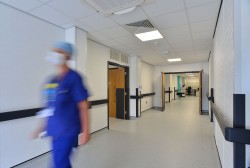David Clowe, Director and Head of MMC at Turner & Townsend tells us how new hospitals are helping galvanise the wider adoption of offsite construction.
Our current economic climate sees us in a period of ‘stagnation’ rather than recession. With material prices rapidly increasing, inflation high and the labour pool tight, construction is finding that it needs to be innovative to do more with less. As our industry also accelerates towards more efficient, sustainable and resilient strategies, modern methods of construction (MMC) are becoming pivotal to the success and sustainability of both public and private sectors across the UK.
This is particularly true of the healthcare sector, where increasing pressure on capital budgets and the net zero promise has put the use of MMC front and centre for enablers. Like many other industries, the UK health service faces pressure to economise and deliver improved services simultaneously. Bolstered by the government’s presumption in favour of MMC, we are seeing firsthand how many MMC techniques can deliver these goals.
To realise this potential, however, we must look at how we invest in building MMC capabilities and nurturing its supply chain.
Rising to the challenge in healthcare
The government’s New Hospitals Programme (NHP) exemplifies its aspirations to reboot the UK’s healthcare provision. This is an essential project of huge scale but in order to meet its demands the Department of Health and Social Care (DHSC) has recognised the need for new ways of working.
MMC is ideal because it’s allowing buildings to progress quickly and precisely. We’ve seen delivery schedules cut by half and the merits of being able to operate in tight, live city centre environments with relative ease.
The recognised environmental benefits of MMC are also a major draw as healthcare construction looks to keep its net zero promises. From the reduction in embodied carbon inherent in the use of recycled and low carbon products, to the improved airtightness and thermal properties resulting from MMC’s greater construction precision – these factors are no longer nice-to-haves and are now central to MMC’s appeal to programmes like NHP.
Our own ongoing work with the Northumberland Healthcare Trust is helping deliver 650 pre-assembled modules (PAMs) and 17 prepacked MEP POD’s, using a Design for Manufacture & Assembly (DfMA) approach to Berwick Hospital – providing a quick and crucial upgrade to the local community. At a time where pressures on skilled workforces are high, MMC’s factory set-up provides greater resilience to the unpredictability of labour costs and other supply chain risks.
Hospitals, and particularly wards and ancillary areas, are designed in such a way that they can be easily repeatable at a high volume, which is ideal for modular construction work. The consistency of pre-fabrication as well as its quality and precision are well suited to the stringent demands of clinical space. Its repeatability also leads to a reduction in the design time and sign-off period, with aggregated demand of the premanufacture of repeatable components at scale reducing costs and providing predictability.
Building momentum in new sectors
The integration of a Platform design approach to construction within the government’s NHP is an encouraging sign for MMC. It shakes off the image that it is a novel concept and has potential to help propel the sector in the mainstream. To fulfil that ambition, however, more work still needs to be done to build confidence in the sector so that it can invest in the skills and scale-up needed to be truly transformational.
A critical step is to champion and showcase how the sector has changed and matured – playing on the lessons of healthcare. This needs to happen right from the outset of programme and project planning, helping clients understand MMC as an option in the first decision and design stages and setting out the efficiency and value.
To do this, the industry needs to position itself in the context of a wider trend towards digitalisation. Projects comfortable with being digital from first principles, and which use the full range of digital tools, will be a more natural fit for an MMC approach. Options and variations can be assessed using BIM and digital twins to consider best fit MMC solutions which standardise the design.
At the most advanced end, technology like virtual reality and augmented reality can be used to help clients visualise plans and designs and significantly reduce detailing and interface risk. By optimising the design of the product, it is possible to manufacture and assemble structures in ways that are simpler, safer and at a lower cost, while also reducing waste and improving quality. Factories and large sites can become assembly hubs of components and sub-assemblies rather than traditional construction sites.
The key to successful implementation for clients is establishing their MMC strategy as early as possible and finding the right solution for the project or programme. From there, clients need to be given informed decisions to achieve maximum value within the project constraints – identifying the most viable MMC solution.
As clients aspire to deliver faster, greener and smarter large-scale portfolios a shift towards the industrialisation of the construction industry is afoot. This demand, buoyed by a guaranteed pipeline of work to secure inward investment and change, will need the support of a supply chain that can reliably deliver high quality component and products at pace.
In our work, we are seeing this balance already start to shift, with government, major clients and contractors increasingly placing their confidence in MMC, and the results across healthcare demonstrating the approaches’ transformative potential. It’s our responsibility as a sector to now go further – educating the market on the opportunity to embed modern and digital methods across projects and set out the benefits of MMC to clients at the earliest stages. We’re on the cusp of a bright technological future, and it will help the construction industry as a whole better deliver on the needs of the country.
For more information visit: www.turnerandtownsend.com









